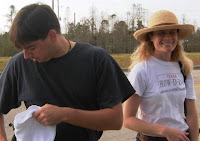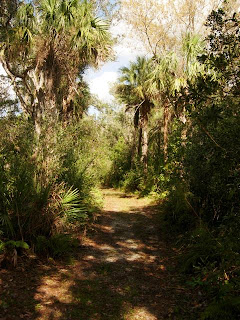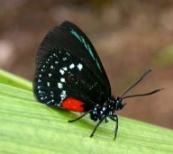January II 2009
 Last minute events and time with my east coast friends has made moving a whirlwind of activities. Photos from the party that Broward County Butterfly Club chapter of the North American Butterfly Association gave for me after my presentation, “Heavenly Hairstreaks and Beautiful Blues” are available to see. I will miss my wonderful friends from BCBC very much, but they have promised to make a field trip visit to me and the amazingly pristine Preserves where I will be working.
Last minute events and time with my east coast friends has made moving a whirlwind of activities. Photos from the party that Broward County Butterfly Club chapter of the North American Butterfly Association gave for me after my presentation, “Heavenly Hairstreaks and Beautiful Blues” are available to see. I will miss my wonderful friends from BCBC very much, but they have promised to make a field trip visit to me and the amazingly pristine Preserves where I will be working.This is a photograph of an intriguing little moth called a Scarlet-Bodied Wasp Moth, (Cosmosoma myrodora). This beautiful moth, with coloration very similar to the atala butterfly, hangs out with the colonies of atalas in the Bahamas. This photo was taken on Andros Island, where atalas and the moths were nectaring on Hempvine (Mikania scandens). I have many photos of them both nectaring together on the masses of wildflowers surrounding the pine rocklands in the yet-undisturbed areas (at least the areas have been undisturbed for a hundred years, since the last clear-cutting of the pines during the late 1800’s and early 1900’s). Another close up can be found at Butterflies and Moths of North America. Art Constantino found the moth on his Beebalm in Fort Lauderdale.
Art's butterfly garden is a wondrous site, and he's been complaining to me that the Monarchs are bossing around the other butterflies; he is plant-sitting my milkweed plants for a few weeks, until I get situated into my new place. In return, though, he gets cuttings and an opportunity to propagate many more milkweed plants for members of Broward NABA and Master Gardeners.
I spent a delightful afternoon walking “The Ridge” with my friend Roberta Shaw, an incredible wildlife photographer and artist. Roberta has been doing “Critter Tales” programs for many years and her work is well known here in South Florida. The link has a lot of neat humane and wildlife education materials to download for free! The Ridge connects to Tree Tops Park, another beautiful oak hammock in west Broward County. We took the time to chat with a few young friends we knew who were doing a special school assignment about pine trees. There are quite a few old pines still to be found scattered along the Ridge, so we could help them out with some questions.
All of south Florida along the “Atlantic Coastal Ridge” used to have thick forests of pines and oaks. The Atlantic Coastal Ridge was a narrow strip of higher-drier land (6-10 miles wide) that extended from Jacksonville down to the Keys, but as far back as the very first explorers, these magnificent trees were simply seen as a resource to be exploited. Most of our glorious ‘resources’ were promptly cut down (here and in the Bahamas). The pines, especially, were hardy, tall, straight and strong, having grown up in the adverse environmental conditions of thin soils, limestone substrates, alternating droughts and floods, and seasonal hurricanes as well! This made our famous “Dade County Pines” (Pinus elliotii var. densa) extremely tough, termite resistant, and dense. The wood was so hard that it had to be drilled before it could be nailed, or it would break the nails!
Needless to say, it was valuable for building sturdy houses along the coast. The very old wooden houses you can still see occasionally are made from “Dade County Pine.” But the forests are almost gone now (see Miami-Dade County’s website for maps of the changes in the forest cover). The trees that are standing now are almost all evenly aged and have very small diameters because they are the first growth after the clear-cutting took place. In the old days, those trees were massive, as were the old cypress trees that lined Big Cypress Preserve. Here’s a picture of me with what was the oldest pine in Oslo River Conservation Area (ORCA) in Indian River County several years ago. The grand old tree was hit by Hurricane Wilma and downed. How sad to think of the acres and acres of huge pines cut down! (And oaks, and cypress…..the tree-hugger in me is showing….)
Here’s a picture of me with what was the oldest pine in Oslo River Conservation Area (ORCA) in Indian River County several years ago. The grand old tree was hit by Hurricane Wilma and downed. How sad to think of the acres and acres of huge pines cut down! (And oaks, and cypress…..the tree-hugger in me is showing….)
All of south Florida along the “Atlantic Coastal Ridge” used to have thick forests of pines and oaks. The Atlantic Coastal Ridge was a narrow strip of higher-drier land (6-10 miles wide) that extended from Jacksonville down to the Keys, but as far back as the very first explorers, these magnificent trees were simply seen as a resource to be exploited. Most of our glorious ‘resources’ were promptly cut down (here and in the Bahamas). The pines, especially, were hardy, tall, straight and strong, having grown up in the adverse environmental conditions of thin soils, limestone substrates, alternating droughts and floods, and seasonal hurricanes as well! This made our famous “Dade County Pines” (Pinus elliotii var. densa) extremely tough, termite resistant, and dense. The wood was so hard that it had to be drilled before it could be nailed, or it would break the nails!
Needless to say, it was valuable for building sturdy houses along the coast. The very old wooden houses you can still see occasionally are made from “Dade County Pine.” But the forests are almost gone now (see Miami-Dade County’s website for maps of the changes in the forest cover). The trees that are standing now are almost all evenly aged and have very small diameters because they are the first growth after the clear-cutting took place. In the old days, those trees were massive, as were the old cypress trees that lined Big Cypress Preserve.
 Here’s a picture of me with what was the oldest pine in Oslo River Conservation Area (ORCA) in Indian River County several years ago. The grand old tree was hit by Hurricane Wilma and downed. How sad to think of the acres and acres of huge pines cut down! (And oaks, and cypress…..the tree-hugger in me is showing….)
Here’s a picture of me with what was the oldest pine in Oslo River Conservation Area (ORCA) in Indian River County several years ago. The grand old tree was hit by Hurricane Wilma and downed. How sad to think of the acres and acres of huge pines cut down! (And oaks, and cypress…..the tree-hugger in me is showing….)  Anyway, it is always a delight when I spend the day with friends, especially when we are outside enjoying Florida’s amazing eco-systems! I also spent an afternoon with Dr Joshua Feingold and his equestrian wife, Laurie Flebotte, at a horse show this weekend. I know their horses well, but this is the first time I’ve seen a horse show, so it was a fun event. This is Laurie's gorgeous horse, Austin’s Wolf, affectionately called “Wolfie”. He has quite the personality! This is Laurie and Wolfie before their jump event.
Anyway, it is always a delight when I spend the day with friends, especially when we are outside enjoying Florida’s amazing eco-systems! I also spent an afternoon with Dr Joshua Feingold and his equestrian wife, Laurie Flebotte, at a horse show this weekend. I know their horses well, but this is the first time I’ve seen a horse show, so it was a fun event. This is Laurie's gorgeous horse, Austin’s Wolf, affectionately called “Wolfie”. He has quite the personality! This is Laurie and Wolfie before their jump event. They won some ribbons, too!

I want to let everyone know that Janice Malkoff will be teaching a great class about butterfly gardening this semester and I urge you to learn about it from one of our NABA experts! You can find information at Broward County Public Schools Adult Education.
Certify your garden at http://www.nababutterfly.com/. Broward NABA chapter is being offered a discounted fee to certify our gardens for this month. Check out the web site. (Art Constantino and I submitted lots of photos and info for the site!) It includes lists of plants for your specific area and the national office is seeking your input on what works well in your garden. It is a truly interactive site designed to help you get the most out of your butterfly garden.
Looking forward to Manatee County and hoping you can visit me on the west coast to participate in some of our exciting events! Kayaking, biking, hiking, butterfly and birding trips, photography workshops, exotic plant removals, and I even get to do dog walks. Life could not be better!
"If a man walks in the woods for love of them half of each day, he is in danger of being regarded as a loafer. But if he spends his days as a speculator, shearing off those woods and making the earth bald before her time, he is deemed an industrious and enterprising citizen." --Henry David Thoreau
Labels: atala butterflies, Butterfly Gardening, Manatee County, Pine Rocklands














